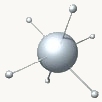|
CG03: The Art of SIGGRAPH 2003 is an exhibition that embodies
the rich spirit of artistic truth and expression through digital
technologies. Although there are valid cautions concerning the
mix of art and the technological ethos, CG03 is evidence that
artists can balance technology with meaning without having technology
dominate them or their ideas. Jeanne Randolph coined
the term technological ethos [Randolph 91], or an ideology that
includes a worldview that is productive and meaningful for many
instances, especially industry and science. In a recent presentation
at the Banff New Media Institute [Randolph03], Randolph
explained that the technological ethos includes an ethic of "getting
the job done," which, as she pointed out, is appropriate
for non-cultural work. It does not, however, include the same
ethics and meaning that artmaking embodies. In the context of
art and science collaborations, Randolph explained that those
working from the philosophical stance of the technological ethos
might not understand that shaping culture is not necessarily a
job; rather, it is about creating meaning. Art, which she includes
in cultural work, is inherently about meaning and ethics. She
claimed that when an artist enters into collaboration with those
who hold to the technological ethos, she puts meaning and ethics
into jeopardy. She further argued that technology can seduce an
artist, and in so doing, can inhibit creativity, ethics, and meaning
and contribute to exploitation.
I propose that those artists who use contemporary digital technology
are in a way collaborating with others who have created it
and are making a choice to do cultural work within the realm of
the technological ethos. I believe that, in a time characterized by
our society's obsession with technology, Randolph's concerns
about seduction and the loss of meaning in such collaborations
are compelling; however, they do not have to apply.
Instead, many artists who make works using digital technology
bend the medium so it works to serve the artistic ethics of truth,
meaning, and expressive ideas. The works in the SIGGRAPH
2003 art exhibition are lucid examples of how artists can balance,
if not overcome the technological ethos to create lush,
aesthetically pleasing, and meaningful works that explore
ideas such as the self, culture, politics, ethics, and the effect of
digital technology on art and society. According to the chair of
CG03 Michael Wright,
"...[the works represent] artists' ideas, thoughts, and truths,
reflecting the layered, non-linear, pluralistic nature of our
times..." [Wright03]. The exhibition contains an astonishing
189 works including sculpture, two-dimensional pieces, digital
video and animation, as well as six critical essays. After 30
years of SIGGRAPH annual conferences, the 2003 art gallery
returns to the roots of computer graphics with a focus on animation
and video, print, and sculpture, thus emphasizing artistic
expression that transcends the underlying technology.
The artists in the SIGGRAPH 2003 exhibition directly challenge
the technological ethos to address truth, aesthetics,
meaning, and ethics. Works by Quintin Gonzalez, Dorothy
Krause, Tina Bell Vance, Celeste Joy Greer (et al.), and Joon
Y. Lee, to name a few, twist and reconfigure technology in
ways that equalize any negative residue that a technically
obsessed culture might leave on expressive artworks.
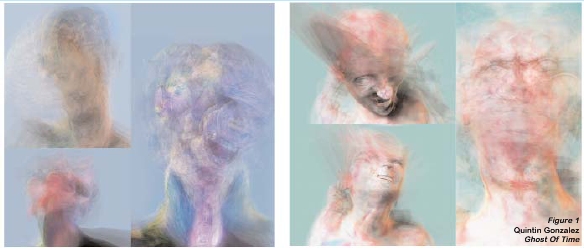
Quintin Gonzalez's Ghost Of Time (Figure 1) is a narrative
series of images that show movement through the marking of
surface kinetics. His abstraction of the human form evokes
mysticism that builds a connection between the abstracted digital
representation of humans and the sacred. The blurred
faces appear ominous yet approachable and their implied
movements evoke the equally contradictory emotions of fear
and curiosity. The faces seem to flow from frame to frame,
creating a formal balance of color and design. The work
includes natural and digital samplings that the artist uses to
create a new meaning played out through the interaction
between the machine and the artist. According to Gonzalez,
"This new meaning of digital technology's function
is one where the machine serves an esoteric, spiritual,
and often an irrational purpose." Perhaps the
machine influenced the work, however, it is the
interplay between Gonzalez and the computer that
creates the artists' final imagery. He harnesses the
narrative language that technology is capable of
and presents it as a digital aesthetic.
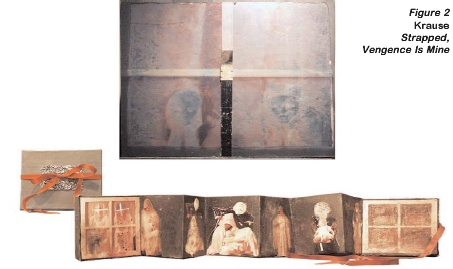 Dorothy Krause's sculptural works (Figure 2) also
play a part in defining a digital aesthetic, however,
hers is more directly part of the larger art continuum.
In the near future, as Ann Spalter [Spalter03]
predicts, digital arts will be embedded in much of
what we do artistically to the point of making it
almost invisible. Krause's work grows from the tradition
of her formal training as a painter and her
natural inclination towards collage. She uses simple
materials such as plaster, tar, wax, and pigment
along with contemporary technology to create
works that are timeless and evoke emotions such
as hope, fear, and immortality. Although not literal,
her work directs the viewer to look beyond the initial
impression for hidden truth. Vengeance Is Mine is
an accordion book that leads the viewer down a
narrative path of symbolism and meaning. Strapped
is a rich mixed media image that pictures two feminine
faces next to one another, thus setting up possibilities
for the viewer to contemplate the relationship
between two people or see them as sides to
a single self. In the end, her work evokes individual
responses that carry meaning void of technical
overindulgence.
Dorothy Krause's sculptural works (Figure 2) also
play a part in defining a digital aesthetic, however,
hers is more directly part of the larger art continuum.
In the near future, as Ann Spalter [Spalter03]
predicts, digital arts will be embedded in much of
what we do artistically to the point of making it
almost invisible. Krause's work grows from the tradition
of her formal training as a painter and her
natural inclination towards collage. She uses simple
materials such as plaster, tar, wax, and pigment
along with contemporary technology to create
works that are timeless and evoke emotions such
as hope, fear, and immortality. Although not literal,
her work directs the viewer to look beyond the initial
impression for hidden truth. Vengeance Is Mine is
an accordion book that leads the viewer down a
narrative path of symbolism and meaning. Strapped
is a rich mixed media image that pictures two feminine
faces next to one another, thus setting up possibilities
for the viewer to contemplate the relationship
between two people or see them as sides to
a single self. In the end, her work evokes individual
responses that carry meaning void of technical
overindulgence.
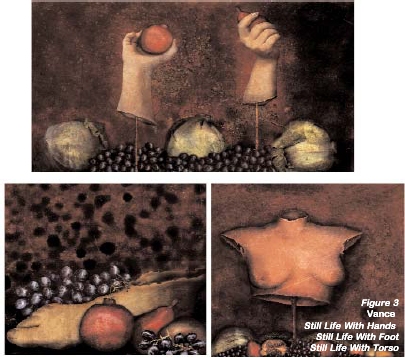 Like Krause, Tina Bell Vance makes works that visibly
extend established media into the digital realm.
Vance's work appears both painterly and photographic
at once and in effect, challenges traditional
forms. More importantly, she uses digital technology
to direct these new forms into meaningful work
that comments on personal and political issues.
With her works in CG03, Still Life With Hands, Still
Life With Foot, and Still Life With Torso (Figure 3),
Vance calls into question politics associated with
the body. For example, what are the implications of
body dismemberment? What could the erosion of a
body imply? Although decaying, these eroding
body parts are quite beautiful and, pictured next to
succulent fruits, posed in a way that references yet
redefines the traditional still life. Perhaps this is a
commentary about age or decay and the beauty in
the process. All these notions touch on issues as
complex as the role of the body in technology or as
simple as the beauty of decay. In showing work
that evokes such ideas, Vance addresses ethical
issues that are key to the artist's role in our society.
Although facilitated by technology, her work serves
and helps define and reflect our culture. At the
same time, it is the technology that feeds some of
the issues she raises, thus it acts as meaningful
capital in the flow of creative thought.
Like Krause, Tina Bell Vance makes works that visibly
extend established media into the digital realm.
Vance's work appears both painterly and photographic
at once and in effect, challenges traditional
forms. More importantly, she uses digital technology
to direct these new forms into meaningful work
that comments on personal and political issues.
With her works in CG03, Still Life With Hands, Still
Life With Foot, and Still Life With Torso (Figure 3),
Vance calls into question politics associated with
the body. For example, what are the implications of
body dismemberment? What could the erosion of a
body imply? Although decaying, these eroding
body parts are quite beautiful and, pictured next to
succulent fruits, posed in a way that references yet
redefines the traditional still life. Perhaps this is a
commentary about age or decay and the beauty in
the process. All these notions touch on issues as
complex as the role of the body in technology or as
simple as the beauty of decay. In showing work
that evokes such ideas, Vance addresses ethical
issues that are key to the artist's role in our society.
Although facilitated by technology, her work serves
and helps define and reflect our culture. At the
same time, it is the technology that feeds some of
the issues she raises, thus it acts as meaningful
capital in the flow of creative thought.
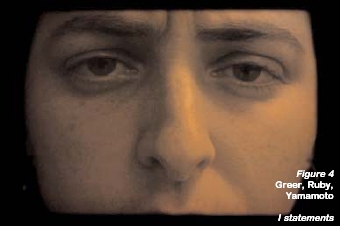 Just as digital technology has extended and fed
sculptural and image-based media, it has also
impacted time-based media. Although work based
in time goes back to the beginning of human artistic expression, digital
processes have added to this kind of art, thus broadening the possibilities in
media such as video, film, animation, and in interactivity. The apparent ease
of using such technology has seduced many people, but artists making
meaningful and aesthetically rich art have thankfully prevailed. One example
from the CG03 gallery is Celeste Joy Greer's, Nicole Ruby's, and Mark
Yamamoto's digital video I Statements (Figure 4), which is a piece about
pain and the cycles associated with it. The artists use the word 'I' to make the
viewer think about the individual pain of the speaker. The use of this kind of
micro-introspection invites the viewers to go into themselves to then emerge
with some kind of meaningful connection with the artist. The artists strive
to speak to each person and make a unique connection. The act of
connecting becomes universal in that no viewer emerges untouched. This
is part of the core of art, and computer graphics technology can enable it.
In making the video, there were moments that were too personal for the
artist to communicate in front of her collaborators. In their place, the camera
stood collecting the information, preparing it for digital manipulation that
would make the segment palatable. The digital processing enabled the
artists to work with raw emotion that they could manipulate and translate
into a form that others could enter. The work is a 30-minute "stream of consciousness"
expression of pain that was distilled down from hours of
footage and then stitched together to form
a poignant work about grief. Rather than
directing and overwhelming the work, digital
technology made possible the transformation
of raw emotion into a work of
art. The idea of processing emotion
through technology and ending with art
that embodies mediated emotive
intensity speaks to the current and
future possibilities of human co-existence
with technology and the balance that we
can enforce with the technological ethos.
In addition to processing already existing
forms of media, such as film and video,
computer graphics technology provides a
way for artists to make digital animations
that are wholly created within the space
of the computer, minus a few scanned
textures. When artists are not mimicking
film or other existing media, these animations
often create works that are unique
in look and offer a new sense of reality.
We have come to think of film as reality
yet it is in fact only one form of it.
Perhaps, as Lev Manovich suggests
[Manovich96], the different reality that the
digital medium yields is one that is overreal,
or hyper-real. Computer graphics
technology is now capable of giving us
more information than we can process,
certainly different from the reality that we
have come to know from traditional film
and photography. This intriguing transformation
can be technologically seductive
to the point of technical obesity, and there
are certainly plenty of Hollywood fiascos
that support this thesis. However, serious
artists are playing with this new form of
reality to create works that, as I have
shown with other digital works from the
SIGGRRAPH 03 exhibition, embrace the
values of art.
Just as digital technology has extended and fed
sculptural and image-based media, it has also
impacted time-based media. Although work based
in time goes back to the beginning of human artistic expression, digital
processes have added to this kind of art, thus broadening the possibilities in
media such as video, film, animation, and in interactivity. The apparent ease
of using such technology has seduced many people, but artists making
meaningful and aesthetically rich art have thankfully prevailed. One example
from the CG03 gallery is Celeste Joy Greer's, Nicole Ruby's, and Mark
Yamamoto's digital video I Statements (Figure 4), which is a piece about
pain and the cycles associated with it. The artists use the word 'I' to make the
viewer think about the individual pain of the speaker. The use of this kind of
micro-introspection invites the viewers to go into themselves to then emerge
with some kind of meaningful connection with the artist. The artists strive
to speak to each person and make a unique connection. The act of
connecting becomes universal in that no viewer emerges untouched. This
is part of the core of art, and computer graphics technology can enable it.
In making the video, there were moments that were too personal for the
artist to communicate in front of her collaborators. In their place, the camera
stood collecting the information, preparing it for digital manipulation that
would make the segment palatable. The digital processing enabled the
artists to work with raw emotion that they could manipulate and translate
into a form that others could enter. The work is a 30-minute "stream of consciousness"
expression of pain that was distilled down from hours of
footage and then stitched together to form
a poignant work about grief. Rather than
directing and overwhelming the work, digital
technology made possible the transformation
of raw emotion into a work of
art. The idea of processing emotion
through technology and ending with art
that embodies mediated emotive
intensity speaks to the current and
future possibilities of human co-existence
with technology and the balance that we
can enforce with the technological ethos.
In addition to processing already existing
forms of media, such as film and video,
computer graphics technology provides a
way for artists to make digital animations
that are wholly created within the space
of the computer, minus a few scanned
textures. When artists are not mimicking
film or other existing media, these animations
often create works that are unique
in look and offer a new sense of reality.
We have come to think of film as reality
yet it is in fact only one form of it.
Perhaps, as Lev Manovich suggests
[Manovich96], the different reality that the
digital medium yields is one that is overreal,
or hyper-real. Computer graphics
technology is now capable of giving us
more information than we can process,
certainly different from the reality that we
have come to know from traditional film
and photography. This intriguing transformation
can be technologically seductive
to the point of technical obesity, and there
are certainly plenty of Hollywood fiascos
that support this thesis. However, serious
artists are playing with this new form of
reality to create works that, as I have
shown with other digital works from the
SIGGRRAPH 03 exhibition, embrace the
values of art.
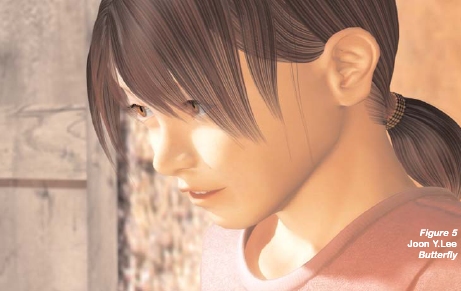 Joon Y. Lee employs the hyper-real quality
of computer graphics technology to
shock the audience in his digital animation
Butterfly (Figure 5). The piece starts
off innocently, if not cliché, with a solemn
girl who is cheered by a passing butterfly.
As the insect interacts
with her she is
pulled into its beauty
and learns to trust
and follow it.
Intentionally or not,
the butterfly leads
the girl to a landmine
where she meets her
death. The work is
oozing with political
irony and implications.
Some questions
include, "What
political body could
the butterfly represent?,"
"Where is
this taking place?," "Who planted the
landmine and why?," to name a few. The
artist uses the hyper-real nature of digital
animation to bring the audience into a
pleasing and overly sappy world only to
shock them into political reality.
The altered reality of the digital medium is
an optimal way for artists to suggest a
new way of seeing things, thus taking a
part in defining our culture. As such, the
works in CG03: The Art of SIGGRAPH
2003 play a part in characterizing the digital
aesthetic, one that brings along with it
the traditional art values of ethics and
meaning. After all, art includes a role in
defining culture, one that is inherent to
art regardless of the medium.
In The Language of New Media,
Manovich [Manovich01] challenges us to
help fully define the expressive possibilities
and attributes of digital and new technologies.
This will force artists to probe
technology and in some ways make commentary
about it, which should not to be
confused with the technological ethos. It
is good to be cautious and to heed the
temptation to let the obsession with technology
take over the 'truth' in art, or defining
culture. As evidenced by the work in
the SIGGRAPH 03 art exhibition, there
are many artists who have managed to
work the technology in their favor and
who have kept overindulgence in it at bay
to create rich and meaningful works of
art.
Joon Y. Lee employs the hyper-real quality
of computer graphics technology to
shock the audience in his digital animation
Butterfly (Figure 5). The piece starts
off innocently, if not cliché, with a solemn
girl who is cheered by a passing butterfly.
As the insect interacts
with her she is
pulled into its beauty
and learns to trust
and follow it.
Intentionally or not,
the butterfly leads
the girl to a landmine
where she meets her
death. The work is
oozing with political
irony and implications.
Some questions
include, "What
political body could
the butterfly represent?,"
"Where is
this taking place?," "Who planted the
landmine and why?," to name a few. The
artist uses the hyper-real nature of digital
animation to bring the audience into a
pleasing and overly sappy world only to
shock them into political reality.
The altered reality of the digital medium is
an optimal way for artists to suggest a
new way of seeing things, thus taking a
part in defining our culture. As such, the
works in CG03: The Art of SIGGRAPH
2003 play a part in characterizing the digital
aesthetic, one that brings along with it
the traditional art values of ethics and
meaning. After all, art includes a role in
defining culture, one that is inherent to
art regardless of the medium.
In The Language of New Media,
Manovich [Manovich01] challenges us to
help fully define the expressive possibilities
and attributes of digital and new technologies.
This will force artists to probe
technology and in some ways make commentary
about it, which should not to be
confused with the technological ethos. It
is good to be cautious and to heed the
temptation to let the obsession with technology
take over the 'truth' in art, or defining
culture. As evidenced by the work in
the SIGGRAPH 03 art exhibition, there
are many artists who have managed to
work the technology in their favor and
who have kept overindulgence in it at bay
to create rich and meaningful works of
art.
References:
[Manovich96] L. Manovich. "The
Paradoxes of Digital Photography" in
Photography After Photography : Memory
and Representation in the Digital Age.
Hubertus v. Amelunxen, Stefan Iglhaut,
Florian Rötzer (eds.) Amsterdam: G+B
Arts, 1996.
[Manovich01] L. Manovich. The
Language of New Media. Cambridge,
Mass: MIT Press., 2001.
[Randolph 91] J. Randolph.
"Technology as Metaphor" in
Psychoanalysis & Synchronized
Swimming and other writings on art.
Toronto: YYZ Books, 1991.
[Randolph 03] J. Randolph. 'Creative
Tensions and Identities' during "The
Beauty of Collaboration: Manners,
Methods, and Aesthetics" at the Banff
New Media Institute (BNMI), May 22-25,
2003.
[Spalter03] A. Morgan Spalter. "Will There
Be 'Computer Art' in the Year 2020?" in
SIGGRAPH 2003 Electronic Art and
Animation Catalog. New York, New York:
The Association for Computing
Machinery, Inc., 2003.
[Wright03] M. Wright. Exhibition
Introduction, in SIGGRAPH 2003
Electronic Art and Animation Catalog.
New York, New York: The Association for
Computing
Machinery, Inc., 2003.
|
